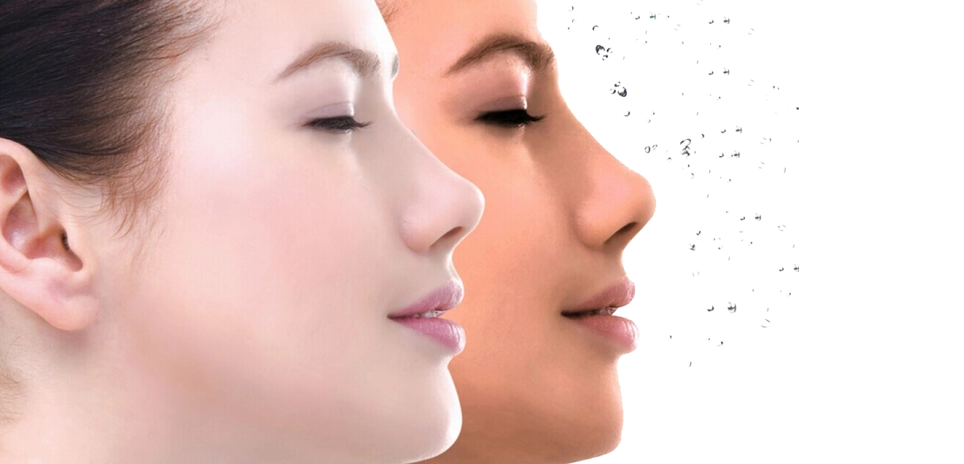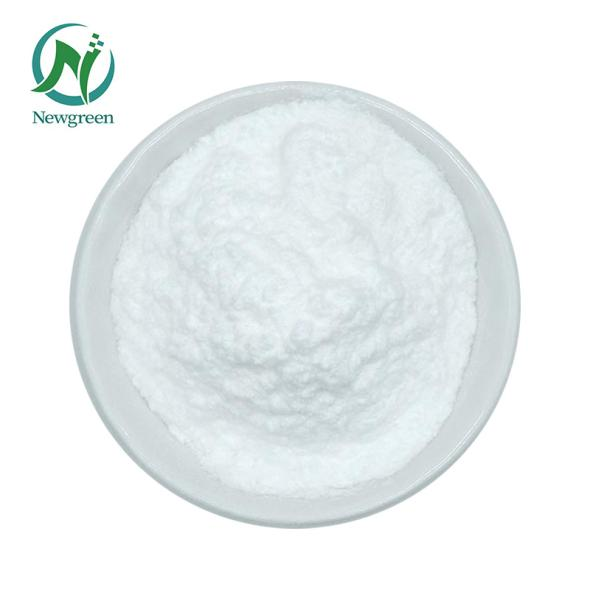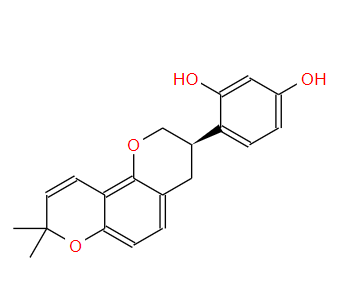
What Is Glabridin ?
Glabridin is a flavonoid extracted from the roots of licorice (Glycyrrhiza glabra) and has a variety of biological activities and health benefits. glabridin is known for its powerful whitening, antioxidant and anti-inflammatory properties and is widely used in skin care and cosmetics.
Glycyrrhiza glabra L. is a perennial herb that grows in southern Europe, Asia, and the Mediterranean region. It is widely planted in Russia, Spain, Iran, and India. The plant of G. glabra is about 1-1.5 meters tall, with small dark green leaves, yellow, blue, and violet flowers, and a sweet rhizome.
Glabridin is one of the main flavonoids in Glycyrrhiza glabra. It shows a strong anti-free radical oxidation effect in the cytochrome P450/NADPH oxidation system, and can significantly inhibit the free radicals produced during the metabolism process in the body to prevent oxidation-sensitive biomacromolecules (low-density lipoprotein LDL, DNA) and cell walls from being damaged by free radical oxidation. This can prevent and treat certain pathological changes related to free radical oxidation, such as atherosclerosis and cell aging. In addition, glabridin has a certain effect of lowering blood lipids and blood pressure. Italian research has also confirmed that Glabridin has an appetite suppressant effect, which can reduce fat without reducing weight. After repeated tests, the main effects are as follows: 1. Whitening, inhibiting melanin; 2. Anti-inflammatory effect; 3. Antioxidant effect; 4. Antibacterial.
Physical And Chemical Properties of Glabridin
1. Chemical Structure
Chemical Name: Glabridin
Chemical Formula: C20H20O4
Molecular Weight: 324.37 g/mol
Structural Characteristics: Glabridin is a flavonoid compound with a typical flavonoid backbone structure. It consists of two aromatic rings (A and B) connected by a three-carbon bridge that forms a closed pyran ring .
2. Physical Properties
Appearance: Glabridin typically appears as a white or pale yellow crystalline powder.
Solubility:
Water: Poorly soluble in water.
Organic Solvents: Soluble in organic solvents such as ethanol, methanol, and propylene glycol.
Melting Point: Approximately 156-158°C (313-316°F).
Odor: Glabridin generally has no distinct odor.
3. Chemical Properties
Stability: Glabridin is relatively stable under normal conditions but can degrade when exposed to light, heat, or acidic conditions. It is recommended to store it in a cool, dry place, away from direct sunlight.
pH Sensitivity: Glabridin is sensitive to pH changes and may degrade in highly acidic or basic environments.
Reactivity: As a flavonoid, glabridin can undergo typical chemical reactions associated with phenolic compounds, such as oxidation and conjugation.


What Are The Benefits Of Glabridin ?
1. Skin Whitening and Brightening
- Inhibition of Tyrosinase: Glabridin is well-known for its skin-whitening properties. It inhibits the activity of tyrosinase, an enzyme crucial for melanin production, thereby reducing the formation of dark spots and hyperpigmentation.
- Even Skin Tone: By reducing melanin synthesis, glabridin helps in achieving a more even skin tone and brighter complexion.
2. Antioxidant Properties
- Free Radical Scavenging: Glabridin has strong antioxidant properties, which help in neutralizing free radicals. This reduces oxidative stress and prevents cellular damage.
- Anti-Aging: The antioxidant activity of glabridin helps in reducing the signs of aging, such as fine lines, wrinkles, and age spots, by protecting the skin from oxidative damage.
3. Anti-Inflammatory Effects
- Reduction of Inflammation: Glabridin exhibits anti-inflammatory properties, which help in reducing skin inflammation, redness, and swelling.
- Soothing Effect: It can soothe irritated skin and is beneficial for conditions like acne, eczema, and rosacea
4. Antimicrobial Activity
- Inhibition of Pathogens: Glabridin has demonstrated antimicrobial properties against various bacteria and fungi. This makes it useful in preventing and treating skin infections.
- Acne Treatment: Its antimicrobial and anti-inflammatory properties make glabridin effective in treating acne by reducing bacterial growth and inflammation.
5. UV Protection
- Photoprotection: Glabridin can provide some level of protection against UV radiation. It helps in reducing UV-induced skin damage, such as sunburn and photoaging.
- Synergistic Effect: When used in combination with other sunscreen agents, glabridin can enhance the overall photoprotective effect.
6. Wound Healing
- Promotes Healing: Glabridin can promote wound healing by reducing inflammation and oxidative stress, and by stimulating the regeneration of skin cells.
- Scar Reduction: It may also help in reducing the appearance of scars by promoting healthy skin regeneration.
7. Hair Care
- Scalp Health: Glabridin's anti-inflammatory and antimicrobial properties can benefit scalp health, reducing dandruff and scalp irritation.
- Hair Growth: By improving scalp health, glabridin may also promote healthier hair growth.
What Are The Applications Of Glabridin ?
Cosmetics and Skincare
1.Skin Whitening Products
- Whitening Creams and Serums: Glabridin is a key ingredient in many skin whitening and brightening products due to its ability to inhibit tyrosinase activity and reduce melanin production.
- Spot Treatments: Used in formulations aimed at reducing dark spots, hyperpigmentation, and uneven skin tone.
2.Anti-Aging Products
- Anti-Aging Creams and Lotions: The antioxidant properties of glabridin help in reducing the signs of aging, such as fine lines, wrinkles, and age spots.
- Eye Creams: Often included in eye creams to reduce dark circles and puffiness.
3.Anti-Inflammatory and Soothing Products
- Soothing Gels and Creams: Glabridin's anti-inflammatory properties make it suitable for products designed to soothe irritated or inflamed skin.
- Acne Treatments: Used in acne treatment products to reduce inflammation and bacterial growth.
4.Sun Protection Products
- Sunscreens: Glabridin can be included in sunscreens to provide additional protection against UV-induced skin damage.
- After-Sun Care: Used in after-sun products to soothe and repair sunburned skin.
Pharmaceuticals
1. Topical Medications
- Anti-Inflammatory Creams: Used in topical medications to treat inflammatory skin conditions such as eczema, psoriasis, and dermatitis.
- Wound Healing Ointments: Included in formulations aimed at promoting wound healing and reducing scar formation.
2. Oral Supplements
- Antioxidant Supplements: Glabridin's antioxidant properties make it a valuable ingredient in oral supplements aimed at reducing oxidative stress and promoting overall health.
- Immune Boosters: Used in supplements designed to enhance immune function due to its anti-inflammatory and antimicrobial properties.
Hair Care
1.Scalp Treatments
- Anti-Dandruff Shampoos: Glabridin's antimicrobial and anti-inflammatory properties make it effective in treating dandruff and scalp irritation.
- Scalp Serums: Used in scalp serums to promote a healthy scalp environment and potentially stimulate hair growth.
2.Hair Conditioners
- Conditioners and Hair Masks: Included in hair care products to provide antioxidant protection and improve hair health.
Food and Beverages
Functional Foods
- Health Drinks: Glabridin can be added to health drinks and functional beverages to provide antioxidant and anti-inflammatory benefits.
- Nutritional Bars: Used in nutritional bars and snacks aimed at promoting overall health and well-being.
Research and Development
Biomedical Research
- Cancer Research: Glabridin is studied for its potential anti-cancer properties, including its ability to inhibit cancer cell growth and induce apoptosis.
- Chronic Disease Research: Investigated for its potential benefits in managing chronic diseases such as diabetes and cardiovascular diseases due to its anti-inflammatory and antioxidant properties.

Related Questions You can Be Interested In :
How long does it take for licorice extract glabridin to lighten skin?
The time it takes for licorice extract containing glabridin to lighten the skin can vary depending on several factors, including the concentration of glabridin in the product, the frequency of application, the individual's skin type, and the severity of hyperpigmentation. Here are some general guidelines and considerations:
1. Typical Time Frame
- Initial Results: Some users may start to see initial improvements in skin tone and a reduction in hyperpigmentation within 2 to 4 weeks of consistent use.
- Significant Results: More noticeable and significant skin lightening effects typically occur after 8 to 12 weeks of regular application.
2. Factors Influencing Effectiveness
Concentration of Glabridin
- Higher Concentrations: Products with higher concentrations of glabridin (e.g., 0.5% to 1%) may produce faster and more pronounced results.
- Lower Concentrations: Products with lower concentrations may take longer to show visible effects.
Frequency of Application
- Daily Use: Applying the product once or twice daily, as recommended, can enhance the effectiveness and speed up the results.
- Inconsistent Use: Irregular application may delay the visible effects and reduce overall efficacy.
Skin Type and Condition
- Skin Type: Individuals with lighter skin tones may notice results more quickly compared to those with darker skin tones.
- Severity of Hyperpigmentation: Mild hyperpigmentation may respond faster to treatment, while more severe cases may take longer to show improvement.
3. Complementary Skincare Routine
- Sun Protection: Using sunscreen daily is crucial when using skin-lightening products to prevent further pigmentation and protect the skin from UV damage.
- Moisturization: Keeping the skin well-moisturized can enhance the absorption and effectiveness of glabridin-containing products.
- Exfoliation: Regular exfoliation can help remove dead skin cells and promote the penetration of active ingredients, potentially speeding up results.
4. Clinical Studies and Evidence
- Clinical Studies: Some clinical studies have shown that glabridin can significantly reduce hyperpigmentation and improve skin tone within 8 to 12 weeks of consistent use.
- User Testimonials: Many users report seeing noticeable improvements in their skin tone and a reduction in dark spots within a few weeks to a few months of regular application.
What are the side effects of the glabridin ?
Glabridin has a variety of biological activities and health benefits, but in some cases, using products containing glabridin may cause some side effects. The following are potential side effects and precautions for glabridin:
1. Skin Irritation and Allergic Reactions
Skin Irritation
- Symptoms: May include redness, swelling, itching, stinging, or burning sensations.
- Causes: Skin sensitivity to glabridin or other ingredients in the product may cause minor skin irritation.
Allergic Reactions
- Symptoms: May include rash, erythema, swelling, or severe itching.
- Causes: Allergy to glabridin or other ingredients in the product, which may trigger an allergic reaction.
2. Photosensitivity
- Increased Sensitivity to Sunlight: glabridin may increase skin sensitivity to sunlight, leading to sunburn or photosensitivity dermatitis.
- Prevention: When using products containing glabridin, it is recommended to use a broad-spectrum sunscreen and avoid prolonged exposure to the sun.
3. Hormonal Effects
- Potential Hormonal Activity: While glabridin is primarily intended for topical use, certain components of licorice (such as glycyrrhizic acid) are known to have steroid-like effects that may affect hormone balance.
- Consideration: When using products containing glabridin in large quantities for a long time, you should pay attention to observe whether there are symptoms of hormonal imbalance.
4. Interactions with Other Skincare Ingredients
- Potential Interactions: glabridin may interact with other active ingredients (such as vitamin C, retinol, etc.), affecting its effectiveness or increasing the risk of side effects.
- Recommendation: When using products containing glabridin, it is recommended to avoid concurrent use of other strong active ingredients or to consult a dermatologist before use.
5. Systemic Effects
- Limited Absorption: glabridin is mainly used for external use and has less systemic absorption, so systemic side effects are less common.
- Precaution: If you experience any discomfort or abnormal reaction, you should stop using it immediately and consult your doctor.
6. Pregnancy and Breastfeeding
- Safety Concerns: There are currently limited data on the safety of glabridin in pregnant and breastfeeding women.
- Recommendation: Pregnant and nursing women should consult their physician before using products containing glabridin.
Post time: Sep-21-2024





